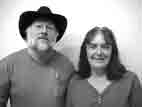 |
Gary & Louise Lee
Gary & Louise Lee have been in business together for over 30 years. They operate Advantage Customs at 6400 N Broadway, one of the leading auto and truck accessories businesses in the Midwest. They are most knowledgeable in all areas including Truck Tops and lids, pickup bed covers, tonneau covers and just about every accessory item manufactured for your car or truck. They custom build "flatbeds" for pickups for farm and ranch uses. Gary and Louise are also heavily involved in "tractor pulls" all around the area, and have won a number of events. You can reach them at (316) 744-0454 , or email them at garanwisey@aol.co |
Cars, Trucks, Vans & Automotive
2003-05-01 11:49:00
History of Toyota
: What is the history of the Toyota company and their Land Cruiser? Is it true it was the vehicle that literally made the company?
ANSWER: We will do our best to answer your questions over the next couple issues (3rd in series... see Mar. ‘03 & Apr. ‘03) There is very little correlation, considering the BJ (Toyota-built prototype that proceeded the Land Cruiser in 1951) has been accused by some to be a copy of the Jeep. The specifications are different because a completely different philosophy was employed in the design of the BJ. The Willys had been designed to be as light as possible, using an engine with roots in automobiles. Because of the low torque characteristics of the engine, a two-speed transfer case with extra gear reduction was used to allow passage over rough terrain. The BJ, on the other hand, was created using components from 2 and 4 ton trucks. The torque from the 6-cylinder B-85 engine did not require the extra gear reduction. Instead a 4-speed transmission with a 5.53:1 first gear was employed to get a little more low-end grunt. The vehicle was dubbed the "Toyota Jeep," possibly as a result of the wording of the U.S. Army's procurement order. Fortunately, the right to the "Jeep" name was owned by Willys who forced Toyota to choose another name. On June 24, 1954, the name "Land Cruiser" was chosen.In 1954, the first Land Cruisers were exported to Pakistan. In 1955, 23 Land Cruisers were exported to Saudi Arabia. The vehicles proved to be wildly popular and exports grew steadily. On Feb 21, 1956, the first two Land Cruisers were exported to Venezuela. These were quickly followed by exports to Burma, Malaysia, and Puerto Rico. Toyota entered the African market by sending Crowns and Land Cruisers to Ethiopia. Because marketing proved difficult with the large number of languages spoken in Africa, Toyota was forced to adopt the sales technique of driving a sample vehicle all over Africa and dealing direct with potential purchasers. The U.S.A. was somewhat different in that in 1957, it received two Crowns before any Land Cruisers. However, the Crowns were found to perform poorly at the higher speeds of American Interstates. Toyota was forced to halt passenger car importing in 1960, leaving only the Land Cruiser to bear the company's name in the United States.Toyota did not make the same mistake in Australia. The first vehicles sent there were Land Cruisers. They arrived in July 1959, and were marketed by Theiss Sales as commercial vehicles. Toyota began to market the Model DA60 truck, its first powered by a diesel engine, in March 1957. However, brand loyalty was strong in Japan so Toyota was forced to establish links to Hino Motors, a diesel truck manufacturer. Hino would later provide the B and H series diesel engines used in Land Cruisers. In May, 1959, Toyota began Land Cruiser assembly in Brazil. This was the first case of knock-down kits being assembled outside Japan. Land Cruiser assembly started in 1963 in Venezuela, 1970 in Indonesia and Pakistan (although Pakistani production was terminated in 1986), and 1977 in Kenya, and 1982 in Bangladesh. Toyota's first exports to Europe were to Denmark, in 1964. That was quickly followed by exports to Finland, the Netherlands, Belgium, Switzerland, Great Britain, France, Italy, Austria, Greece, and finally, Germany. It was not until 1964 that Toyota came to Canada. The first vehicles imported were the Crown, Land Cruiser, and Publica. The Publica proved to be unsuitable for the Canadian climate and was quickly withdrawn; however, by 1971, largely on the strength of Land Cruiser sales, Toyota had become the number one import brand in Canada. Throughout the history of Toyota, it was the Land Cruiser that led the way into new export markets and proved Toyota’s toughness.


